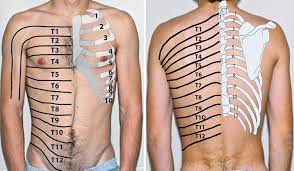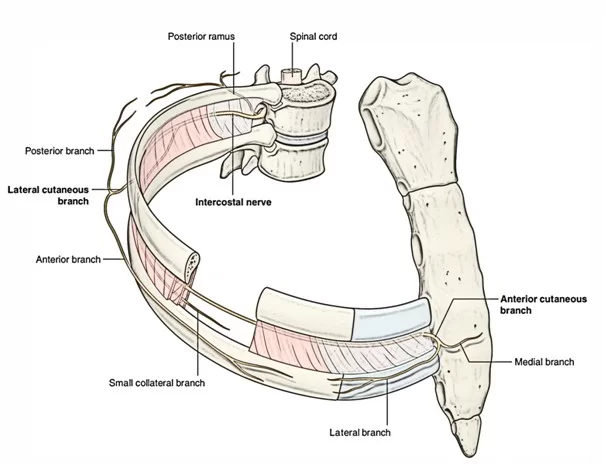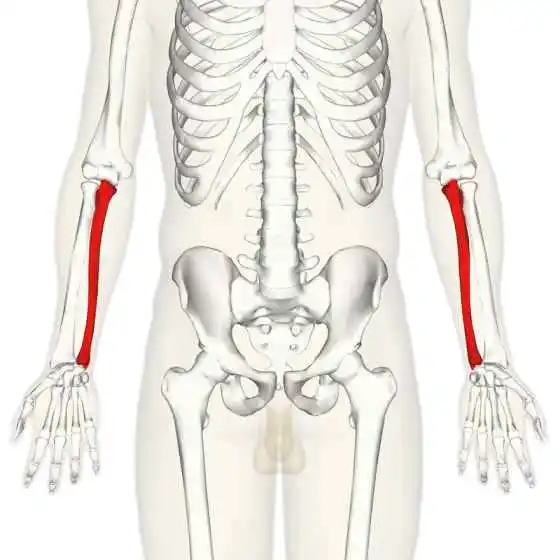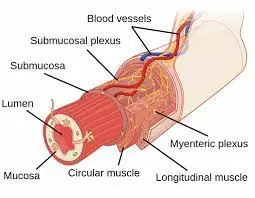Intercostal nerves
Introduction
The intercostal nerves originate in segments from the anterior/ventral rami of thoracic spinal nerves T1 to T11. The term ’intercostal’ mention to their course in the intercostal space, in which they run alongside intercostal vessels. The anterior rami of the most inferior thoracic spinal nerve (T12) give rise to the subcostal nerve which runs inferior to the twelfth rib, the “subcostal space”.
The intercostal nerves are a mixed type of nerves, that carry motor and sensory fibers. The main function of the intercostal nerves is to provide segmental supply to the structures of the thoracic wall and abdominal wall. In addition to their motor supply for intercostal muscles, and muscles of the anterolateral abdominal wall, they carry sensory afferent fibers from the skin of the thoracic and abdominal wall, ribs, pleura, and peritoneum. These nerves also carry sympathetic supply to structures (sweat glands, blood vessels) of the thoracic and abdominal walls.
The course of intercostal nerve
- on arising, each intercostal nerve is connected to its corresponding sympathetic ganglion (of the sympathetic trunk) by preganglionic and postganglionic branches (rami communicates). The intercostal nerves then pass their respective intercostal space between the posterior (internal) intercostal membrane and the parietal pleura.
- The nerves then run anteriorly in the costal grooves next to their corresponding intercostal artery and vein. Although the majority of intercostal nerves follow a similar pattern from origin to course and branches, there are some variations among them. However, the intercostal nerves are divided into typical and atypical types of intercostal nerves. The main reason for this division is that the typical intercostal nerves run solely in their own intercostal spaces, while the atypical spinal nerves go behind the thoracic wall to supply other regions. The term ’typical’ refers normally to the third to the sixth nerve, while the rest are considered to be atypical.
Intercostal nerve 1
- The anterior ramus of the first thoracic spinal nerve terminates by dividing all over the neck of the first rib into two branches: superior and inferior.
- The wide, superior branch leaves the thoracic cavity and joins the brachial plexus. The inferior or lower branch, also known as the intercostal branch, becomes the first intercostal nerve.
- This nerve runs in the first intercostal space (below the level of the first rib) and ends as the first anterior cutaneous branch on the anterior aspect of the chest wall.
Intercostal nerves 2-6
- The anterior rami of the second, third, fourth, fifth, and sixth thoracic spinal nerves enter directly into their communicate intercostal spaces, and run between the parietal pleura and the posterior intercostal membrane. These nerve runs continue anteriorly, running between the innermost intercostal & the internal intercostal muscles. Along their path in the intercostal space, these nerves run within or just below the costal groove, running below the intercostal artery and vein. Near the midaxillary line, each of these nerves gives rise to the lateral cutaneous branches. At the anterior or frontal aspect of the chest wall, close to the sternum, the intercostal nerves pass anterior to the internal thoracic vessels and end by penetrating the internal intercostal muscles and external intercostal membranes between the costal cartilages, and the pectoralis major muscle, come to be anterior cutaneous branches.
- the lateral cutaneous branch of the second intercostal nerve is also known as the intercostobrachial nerve, which supplies the floor of the axilla and upper posteromedial aspect or surface of the upper extremity. In acute or fresh cases of coronary artery diseases (e.g. heart attack), patients normally feel left-sided pain in their axilla and arm. This is cardiac reflective pain that is mediated by the intercostobrachial nerve.
Branches and innervation
- The typical intercostal nerves are the mixed types of nerves carrying both motor and sensory supplies for the thoracic and abdominal walls. across their course, the nerves normally give off some branches:
- The muscular branches for the intercostal muscles, subcostal muscles, serratus posterior superior, levators costarum, and transverses thoracic muscles.
- The cutaneous branches are the lateral cutaneous branches, which again divide into anterior and posterior branches, and the anterior cutaneous branches which also divide into medial and lateral branches. These branches supply segmental sensory supply to the skin of the anterolateral walls of the thorax and abdomen.
- The collateral branches rise close to the angles of the ribs and run along the superior border of the inferior rib to supply the intercostal muscles, parietal pleura, and the periosteum of the rib.
- The communicating branches (rami communicates) are links between each intercostal nerve and the ipsilateral sympathetic trunk. Presynaptic fibers run from the anterior rami of the spinal nerves to the trunks, while the postsynaptic fibers run from the ganglions back to the accessible anterior rami of spinal nerves. The sympathetic fibers then run through the intercostal nerves to reach and supply the blood vessels, sweat glands, and smooth muscle of the body wall and limb.
Intercostal nerves 7-11
- The anterior rami of the last five (seventh, eighth, ninth, tenth, and eleventh) spinal nerves also enter and run in their communicating intercostal spaces. Here, they give supply to the thoracic wall and the intercostal muscles.
- However, after their course in the intercostal spaces, the nerves run behind the costal margin of the abdominal wall where it terminates as anterior cutaneous branches, after piercing the anterior rectus sheath. These intercostal nerves supply the skin and muscles of this region, as well as the parietal peritoneum. Owing to the fact that they supply both thoracic and abdominal walls, these nerves are sometimes also referred to as thoracoabdominal nerves.
Dermatomes

- A dermatome refers to the area of the skin in which sensory nerves supply by the single spinal nerve root. The dermatomes related to the thorax and abdomen are T1-T12.
- Anteriorly, particularly is quite evenly spaced, with T1-T6 being nearly horizontal lines that expand over the thoracic wall.
- Furthermore, the dermatomes T7-T12 begin horizontally in the thoracic wall, but anteriorly, they tend to dip inferiorly and extend onto the abdominal wall.
FAQ
What is distinctive about the intercostal nerves?
Unlike the nerves from the autonomic nervous system that supplies the visceral pleura of the thoracic cavity, the intercostal nerves begin from the somatic nervous system. This allows them to control the contraction of muscles, as well as gives specific sensory information regarding the skin and parietal pleura.
What happens if the intercostal nerve is damaged?
These comprise a sharp, stabbing, burning, or aching pain in the ribs, chest, or abdomen. tingling and numbness type of sensation in the ribs, chest, or abdomen. decreased motor function around the affected area (in severe cases)
What do intercostal nerves supply?
The intercostal nerves are a mixed type of nerves, carrying motor and sensory fibers. Their main function is to give segmental supply to the structures of the thoracic wall and the abdominal wall.
What aggravates intercostal neuralgia?
Pain caused by intercostal neuralgia may intensify with movements such as jumping, coughing, or sneezing. a person might also experience it while breathing in and out, or the person could feel it as referred pain in the shoulder blade, back, or groin region.
What are the branches of intercostal nerves?
Branches
it gives muscular branches to the intercostal muscles, subcostal muscles, serratus posterior superior muscle, and transverses thoracic.
cutaneous branches of intercostal nerve: lateral cutaneous and anterior cutaneous branches.
articular branches to the rib periosteum.
branches to supply the parietal pleura
Are intercostal nerves sensory or motor?
Intercostal nerves are composed of ventral rami of the thoracic roots and are mixed nerves, having the motor and sensory components.
What muscles do the intercostal nerves supply?
the intercostal nerve supplies the rectus abdominis muscle and ends as anterior cutaneous branches of the abdomen supplying the cutaneous sensation to the anterior abdominal wall. The lower intercostal nerves also supply the intercostal muscles and anterior abdominal wall muscles.
What can cause intercostal nerve pain?
Intercostal neuralgia is caused by irritation, inflammation, or compression of the intercostal nerves, which are just below the ribs. A number of things can cause this, including trauma to the chest. viral infections, such as shingles.








3 Comments